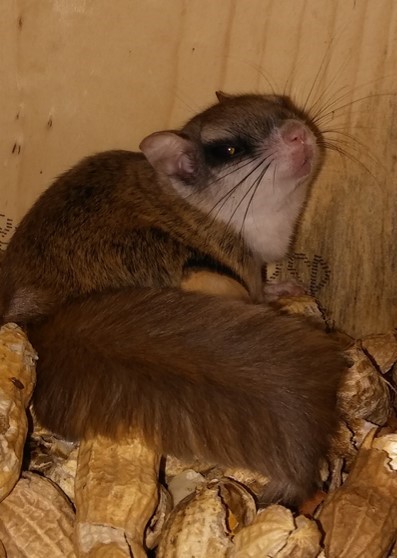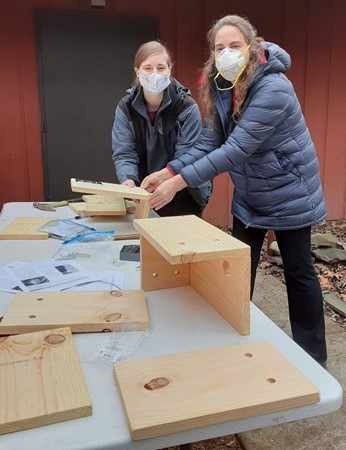
In Fairfax County, the number of flying squirrels may equal that of the common grey squirrel. Soon flying squirrels will be easier to spot as their summer supply of insects dwindles in the coolness of the fall. This charming elusive creature has many adaptations enabling it to hunt and hide. But do flying squirrels really fly?
Flying squirrels are nocturnal members of the rodent family and cousins of our daytime grey squirrels. They are the most carnivorous members of the squirrel family and enjoy insects, spiders and slugs in their diet as well as bird
eggs, nestlings and carrion, depending on the season. In the winter months, when their favorite insects are unavailable, flying squirrels can be enticed into a feeding box after dusk with nuts and seeds. At Hidden Oaks Nature Center in Annandale, one flying squirrel hero is Bob Dinse, one of this year’s Sally Ormsby Environmental Stewardship Award recipient. Bob donates his time, talent and peanuts to keep the flying squirrels attracted to the feeding boxes behind the nature center. Over the last five years, three Boy Scout Eagle projects involved building, posting, cleaning or surveying the six feeding stations. During evening programs, Hidden Oaks staff naturalists open the boxes and share with lucky visitors the amazing sight of a flying squirrel chowing down on peanuts or sunflower seeds.
While reasonably patient with their human observers, the squirrels often scamper out of the box, up the tree and eventually glide to a neighboring tree. Gliding, as opposed to the powered flight of bats or birds, is achieved through use of a patagium, or flap of skin, stretching from the squirrels’ front and hind limbs on both sides of their bodies. Muscle groups under this skin enable the flying squirrel to achieve great accuracy in direction and landing site. Whiskers or vibrissae located on the squirrels’ faces protect their large eyes and assist in navigating dark spaces including their nesting locations in tree cavities, abandoned bird and squirrel nests and, unfortunately, occasionally in attics.
The species here in northern Virginia is the Southern Flying Squirrel, Glaucomys volans, which means “flying grey mouse.” Their fur is indeed a brownish gray which enables them to camouflage against tree trunks. A flattened tail assists in balance and in flight but can also serve as a lifesaver when it “breaks away” in a predator’s teeth or talons. It is not unusual to see a flying squirrel with a non-existent or partial tail. Strong back legs power leaps from trees as they push out and away to begin their glide or shoot up from the ground to avoid a predator. Sharp non-retractable claws and ankles that can rotate 180 degrees allow the squirrel to scamper up and down a tree, always head-first, with an eye as to who or what might be ahead.

Expanding their natural history knowledge has been a rewarding pastime for many area residents during the challenging pandemic era. Fall is here which is the perfect time to build your own flying squirrel feeding box at an upcoming program at Hidden Oaks Nature Center! Last winter, an Eagle scout constructed kits that are all set for upcoming box building programs, Make Your Own Flying Squirrel Feeding Box, on Sunday October 24.
You can also currently register for both Flying Squirrel Campfire programs and Flying Squirrels-Gliding in Tonight in November, and later for those in December-March, to see the flying squirrels at the nature center feeding boxes and cavorting among the trees behind the building. Prefer to enjoy learning about flying squirrels from the comfort of your living room? Hidden Oaks is offering a Zoom program on October 17, Invite Flying Squirrels to Your Yard, where homeowners can learn more about the natural history of these gliders and how to attract them. Learn more about these programs and register online at www.fairfaxcounty.gov/parks/hiddenoaks.
Hidden Oaks is located at 7701 Royce Street, Annandale, VA.
Author Kim Young is a Senior Interpreter with Hidden Oaks Nature Center.
